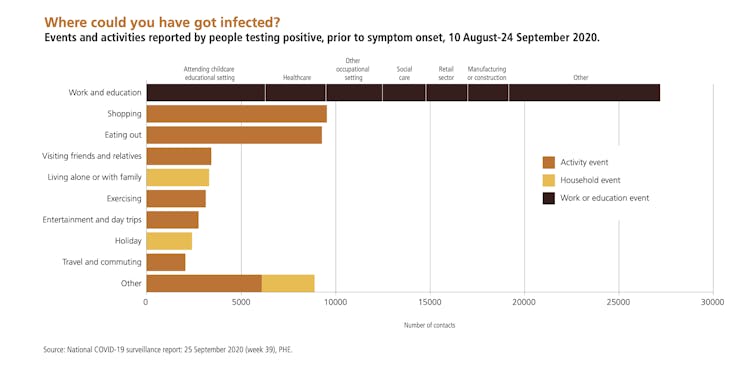
The small town of Watton, Norfolk recently held the unfortunate title of having England’s highest rate of infection with COVID-19 relative to population size, following an outbreak at a food factory.
Despite varying degrees of lockdown restrictions due to the pandemic, many people in the UK are still going in to their workplaces. Factories, warehouses, schools, farms and some shops and hotels are all still open, and all have been sites of workplace clusters of transmission of COVID-19.
Indeed, the first case of the virus spreading in a workplace stretches back to the one in a Wuhan market in China in December 2019. The major means to prevent workplace transmission were then identified at a global and national level early in 2020. Yet UK prevention or even control of workplace COVID clusters is failing, sometimes badly.
Week by week, we continue to get new workplace clusters. The latest weekly surveillance report from Public Health England revealed 397 suspected outbreaks in care homes and 334 incidents in workplaces between October 19 and 25. Care homes are, of course, workplaces too.
Attempts to dismiss workplace clusters as simply due to non-work factors such as travel to and from work and crowded housing, which in themselves are occupationally-related, are not supported by available evidence. So what is going wrong and how can it be put right?
The COVID workplace threat to employees, their families and communities can only come primarily from three factors. First, control measures built into government and government agency “COVID-secure” guidance on things like social distancing, masks, ventilation, cleaning, and testing and contact tracing could be inadequate or wrong.
Second, employer working practices could be poor. Thirdly monitoring, inspection and enforcement of guidance by the health and safety regulators who enforce the law – the Health and Safety Executive (HSE) and in some settings local authority health and safety inspectors – could be deficient. Or there could be a combination of all three factors at work. The problem is that there is little investigation into or publicly available data on what is happening.

Rory O’Neill/Hazards Magazine
One high-risk industry that should have been thoroughly checked for months illustrates the problem. In late October, COVID-19 clusters involving hundreds of workers were still being reported in the East of England meat processing industry. This is despite the fact that the specific risks in the sector became clear at the end of 2019 and means to control risks were widely available by May.
The US government has looked at COVID-19 in workers in 115 meat and poultry processing facilities reported by 19 states up to May 2020. From approximately 130,000 workers at these facilities, 4,913 COVID cases and 20 deaths occurred. Factors potentially affecting infection risks included workplace physical distancing, cleaning and hygiene. No similar statistics for the UK are in the public domain.
In Germany, one large meat processing COVID-19 outbreak, also in May 2020, was immediately investigated and a detailed report found spacing, temperature, humidity and ventilation conditions were all factors in how the virus could be spread over long distances. Again, no such reports have apparently been produced in the UK to examine causes and lessons for the future.
Lack of powers
Investigations of COVID-19 workplace clusters in Britain are led by public health staff at a national and local level and not by the HSE, although joint inspections and investigations may occur. This could could mean some investigators lack the powers and possibly the knowledge and skills to enforce measures to stop the spread of the virus.
The HSE has powers to close a workplace hazardous to health. Local authority inspectors have the power to shut workplaces on environmental health grounds. Directors of Public Health do not have such powers.
Nor, for various reasons connected to patient and commercial confidentiality, have details on working conditions in British meat processing plants with COVID-19 clusters been quickly released by either regulators or public health directors. This lack of information and transparency is proving a major handicap to speedy prevention, along with problems on regulatory inspection, industry practice, worker involvement and flawed government policies.
With winter looming, making workplaces COVID-safe rather than simply COVID-secure is therefore proving a challenge for governments, employers, regulators, and workers. It can be done – and has been elsewhere in the world – by applying the science available, adopting best practice in occupational health and safety, and resolving organisational and policy conflicts and confusion.![]()
Andrew Watterson, Chair in Health Effectiveness, University of Stirling. This article is republished from The Conversation under a Creative Commons license. Read the original article.









